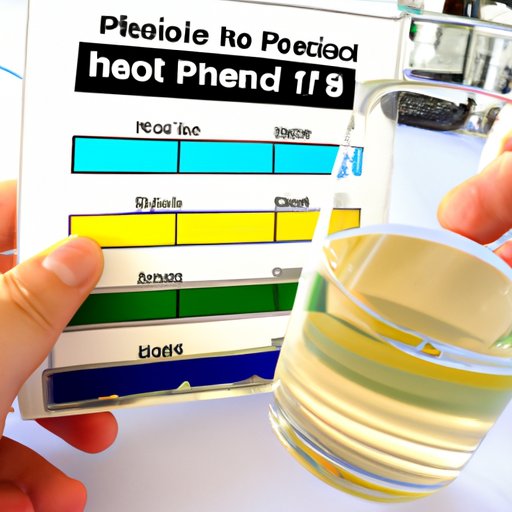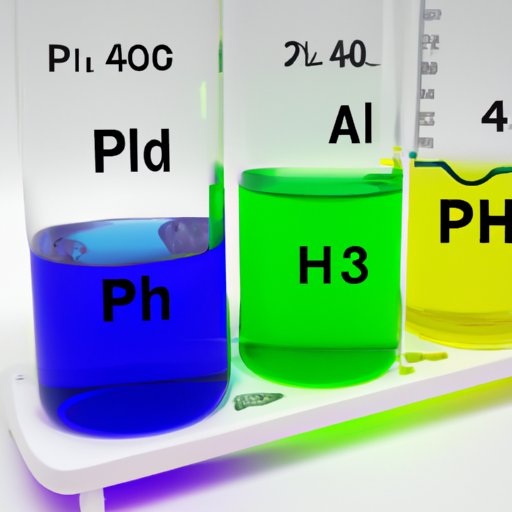Introduction
The pH scale is an important part of understanding chemistry and the environment. It is used to measure the acidity or alkalinity of a given substance and is essential for many everyday activities. In this article, we will explore the basics of pH and how it works, provide a comprehensive guide to understanding the pH scale, examine the range of the pH scale and its uses, look at the chemistry behind the pH scale, investigate the different types of pH testing methods, and explore the relationship between pH and other chemical properties.

Explaining the Basics of pH and How It Works
Before diving into the specifics of the pH scale, let’s start with the basics. What is pH? Put simply, pH is a measure of the acidity or alkalinity of a substance. The term “pH” stands for “potential of hydrogen” and represents the amount of hydrogen ions in a solution. On the pH scale, numbers below 7 indicate an acidic solution, while those above 7 indicate an alkaline solution.
The pH scale ranges from 0 to 14, with 7 being neutral. When a substance has a pH of 0, it is considered to be the most acidic. Conversely, a substance with a pH of 14 is the most alkaline. Most substances have a pH that falls somewhere between these two extremes.
The pH of a given substance can be measured using a variety of methods. One of the most common methods is to use litmus paper, which is a special type of paper that changes color when exposed to an acidic or alkaline solution. Other methods include using a pH meter or indicator solution.
A Comprehensive Guide to Understanding the pH Scale
Now that we’ve covered the basics of the pH scale, let’s take a closer look at how it works. There are several different types of pH testing methods, each of which has its own advantages and disadvantages. For example, litmus paper is inexpensive and easy to use, but it can only provide a rough estimate of the pH level. A pH meter, on the other hand, is much more accurate but is also more expensive and requires more skill to use.
In addition to the type of test used, there are a number of other factors that can affect the pH level of a given substance. Temperature, light, oxygen, and other chemicals can all have an effect on the pH level. Therefore, it is important to consider these factors when measuring the pH of a solution.
Once the pH level of a substance has been determined, it is important to understand how to interpret the results. Generally speaking, substances with a pH lower than 7 are considered to be acidic, while those with a pH higher than 7 are considered to be alkaline. However, it is important to note that the exact pH level of a substance can vary depending on the specific conditions.
Examining the Range of the pH Scale and Its Uses
The range of the pH scale can be used for a variety of different purposes. For example, different types of soil have different pH levels, which can affect the types of plants that can grow in them. Acids such as vinegar and lemon juice have a low pH, while baking soda and bleach have a high pH. Knowing the pH of a given substance can help you determine what type of reaction it will have when mixed with other substances.
The pH scale is also used in everyday life. For example, swimming pools are kept at a certain pH level to ensure that they are safe for swimming. Similarly, water treatment plants use pH tests to make sure that the water coming out of our taps is safe for drinking. The pH of the human body is also carefully monitored to make sure that our bodies stay healthy.

An Overview of the Chemistry Behind the pH Scale
To better understand the pH scale, it is important to understand the chemistry behind it. Acid-base reactions are one of the key components of the pH scale. An acid-base reaction occurs when an acid and a base react with each other, resulting in a neutralization reaction. This reaction produces salt and water, and can cause a change in the pH level of the solution.
For example, if an acid and a base are mixed together, the reaction will result in an increase in the pH level of the solution. Conversely, if an acid and a base are mixed together, the reaction will result in a decrease in the pH level of the solution. Thus, understanding acid-base reactions is essential for interpreting the results of pH tests.

Investigating the Different Types of pH Testing Methods
As mentioned earlier, there are a few different types of pH testing methods. Litmus paper is the most common, but there are also more sophisticated methods such as pH meters and indicator solutions. Each of these methods has its own advantages and disadvantages, so it is important to choose the method that best suits your needs.
For example, litmus paper is inexpensive and easy to use, but it can only provide a rough estimate of the pH level. A pH meter, on the other hand, is much more accurate but is also more expensive and requires more skill to use. Indicator solutions are also relatively accurate, but they can be time-consuming to prepare and require a greater level of expertise.
Exploring the Relationship Between pH and Other Chemical Properties
It is also important to consider the relationship between pH and other chemical properties. For example, pH can affect the solubility of certain substances, as well as their reactivity. In general, acidic solutions tend to be more reactive than basic solutions, and substances that are soluble in acidic solutions may not be soluble in basic solutions.
Similarly, pH can also affect the color of a solution. For example, some substances will change color when exposed to an acidic or basic solution. This phenomenon is known as “acid-base indicators” and can be used to determine the pH level of a solution.
Conclusion
The pH scale is an important tool for understanding chemistry and the environment. It is used to measure the acidity or alkalinity of a given substance and is essential for many everyday activities. In this article, we explored the basics of pH and how it works, provided a comprehensive guide to understanding the pH scale, examined the range of the pH scale and its uses, looked at the chemistry behind the pH scale, investigated the different types of pH testing methods, and explored the relationship between pH and other chemical properties.
To conclude, it is important to remember that the pH level of a substance can vary depending on the specific conditions. Therefore, it is important to consider all the factors that can affect the pH level before attempting to interpret the results of a test. With a better understanding of the pH scale, you can make more informed decisions about the substances you encounter in everyday life.
(Note: Is this article not meeting your expectations? Do you have knowledge or insights to share? Unlock new opportunities and expand your reach by joining our authors team. Click Registration to join us and share your expertise with our readers.)
